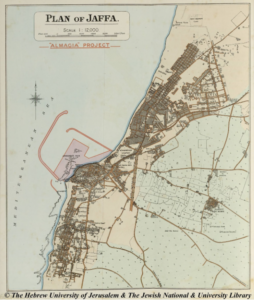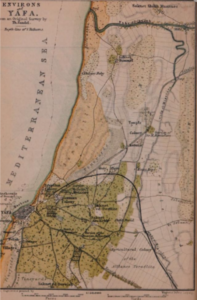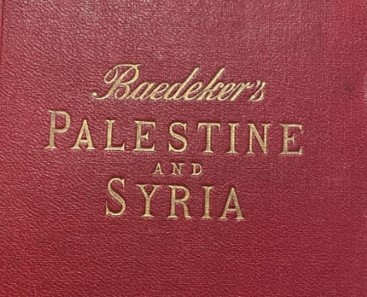From a family of printers, German publisher Karl Baedeker revolutionized the concept of a travel guidebook into a detailed companion rich in information on a given region’s illustrations of must-see attractions, colored folding maps, methods of transportation, fine restaurants, culture, and language all collected and written by specialists of the country. Instantly recognizable by their ordinarily handsome red cloth cover and elegant, italicized golden script, all copies–referred to simply as Baedekers–were editions mass produced for curious tourists, regional scholars and ordinary readers alike. Not well traveled enough to be a tourist or academically adept enough to consider myself a scholar, I was drawn to Karl Baedeker’s Palestine and Syria as it aligned with two courses I’m currently taking: “Islam and the West” and “Religion and Politics in the Middle East and North Africa”. With the hope I could use the content of these courses to inform my understanding of Palestine and Syria, the adventure began.
Despite its modest size (dimensions measuring 6 x 4 x 1 inches, or 16 x 11 x 3 centimeters), it carries a comfortable and compact weight. The copy’s pages are thin and delicate, and turned golden with age. The foreedge is decorated with a simple marbling pattern, resembling a repeated “C” motif. 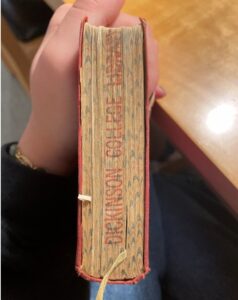
A few pages are marked with water damage and have fraying corners, no doubt having endured years of use. Its once sharp corners have softened and bent. What strikes me as most noteworthy about the condition of this book is the crown of the spine and the pages listing other existing Baedeker guidebooks. The spine and pages listing other copies are in the worst condition
.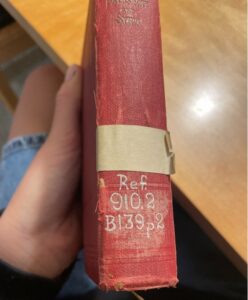
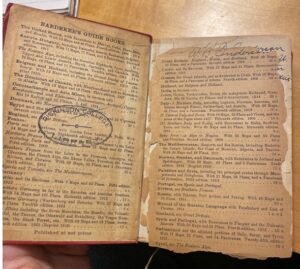
The red cloth on the spine has started to peel, revealing the bones of the book: its backboard and a peek of binding. The first few pages were brown and disintegrating with age, so that just touching them threatened the paper to crumble. Could the cloth have given out from years of living on a shelf, getting picked off by the top of its spine? Which theoretical lifetime was this? An academic’s copy? Were the pages left out in the sun? Tea spilled across them? Why are these pages in such delicate condition? The more I looked, the more questions I had.
A library stamp from Dickinson College on the inside cover mirrors the name and address of a former owner:
WB Anderson
5214 Foureno dr.
Philly, PA USA
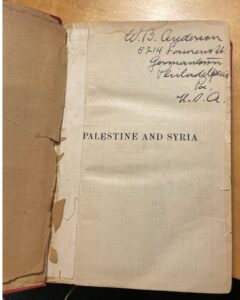
While it could be argued this book has passed through the hands of multiple different owners, for the sake of this project we will consider WB Anderson and Dickinson College as the primary former holders. I can’t help but wonder how Anderson might have acquired this book….Was it purchased for pleasure reading? For academic interest? Despite endless searching, the name and address lead me to a dead end. Palestine and Syria was published in 1912, but wasn’t acquired by Dickinson library until 1931. Where did it spend the first 19 years of its life? With Anderson? Palestine and Syria’s last reader left the guide’s thin, green ribbon of a bookmark open to page 299 on practical notes on Damascus. Curiously, the marker has what looks like pin holes at least an inch between each other. Could this have been a pin cushion for a desperate sewing project? A means of keeping track of needles? A measurement tool? Why are the holes so evenly spaced out between each other? So many questions prompted by such a small strip of fabric!
Curious about how these copies were mass-produced, I consulted an archivist at Dickinson college: Malinda Triller. She explained how as with most mass-produced books, the boards and spine of this book were laid flat. Cloth was then stretched and glued to the book’s skeleton. Its title was then stamped mechanically. I was in awe of the process, having always taken for granted the historical efforts it took to make a modern completed book. From handwritten codexes, to Gutenberg’s moveable type printing press, the mechanical birth of the simple guidebook was preceded by a rich history of the evolution of the written word. To think of the history of bookmaking and what it took for my copy of Palestine and Syria to exist was astonishing.
To my disappointment, Anderson’s copy of Palestine and Syria is devoid of any marks or marginalia. What a powerful clue into the life of this book would writing on the pages have been! The only other mark of a previous owner’s pen besides Anderson’s name and address is an illegible note scrawled near the crease of the preface page. No matter how much I squint, I can’t make out the content of this clue.
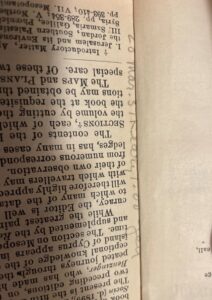
An enthusiastic traveler might have noted in their guide where they might have visited, giving their own accounts of their trip. Did this belong to a reader strictly against writing in books?
Palestine and Syria during the original publication of this guide in 1876 weren’t exactly hot travel destinations for American tourists. Traveling ships to the region were few and far between, the political climate at the time unwelcoming towards tourists. With regards to our 1912 copy, archival records show light traffic between the States and Palestinian and Syrian ports, leaving me to believe this travel guide was used more for armchair traveling than as a practical traveler’s companion. As I continue to uncover Palestine and Syria’s story, I look forward to
discovering all of this travel guide’s history and context.
Works Cited:
Collelo, Thomas. Syria: A country study. Washington, D.C: Federal Research Division, Library
of Congress : For sale by the Supt. of Docs., U.S. G.P.O, 1988.
Works Consulted:
Welcome to Leisure, Travel & Mass Culture: The History of Tourism.” Leisure, Travel & Mass
Culture: The History of Tourism- Adam Matthew Digital. Accessed October 15, 2024.
https://www.masstourism.amdigital.co.uk/.
Individuals consulted:
Ian Boucher, Dickinson College
Malinda Triller, Dickinson College
